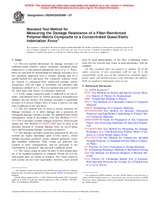We need your consent to use the individual data so that you can see information about your interests, among other things. Click "OK" to give your consent.
ASTM D6264/D6264M-07
Standard Test Method for Measuring the Damage Resistance of a Fiber-Reinforced Polymer-Matrix Composite to a Concentrated Quasi-Static Indentation Force
STANDARD published on 1.11.2007
The information about the standard:
Designation standards: ASTM D6264/D6264M-07
Note: WITHDRAWN
Publication date standards: 1.11.2007
SKU: NS-34445
The number of pages: 11
Approximate weight : 33 g (0.07 lbs)
Country: American technical standard
Category: Technical standards ASTM
Annotation of standard text ASTM D6264/D6264M-07 :
Keywords:
composite materials, damage resistance, delamination, dent, impact, quasi-static indentation, ICS Number Code 83.120 (Reinforced plastics)
Additional information
| 1. Scope | ||||||||||||||||||||||||||||||||||||||
|
1.1 This test method determines the damage resistance of multidirectional polymer matrix composite laminated plates subjected to a concentrated indentation force (Fig. 1). Procedures are specified for determining the damage resistance for a test specimen supported over a circular opening and for a rigidly-backed test specimen. The composite material forms are limited to continuous-fiber reinforced polymer matrix composites, with the range of acceptable test laminates and thicknesses defined in 8.2. This test method may prove useful for other types and classes of composite materials. 1.2 A flat, square composite plate is subjected to an out-of-plane, concentrated force by slowly pressing a hemispherical indenter into the surface. The damage resistance is quantified in terms of a critical contact force to cause a specific size and type of damage in the specimen. 1.3 The test method may be used to screen materials for damage resistance, or to inflict damage into a specimen for subsequent damage tolerance testing. The indented plate can be subsequently tested in accordance with Test Method D 7137/D 7137M to measure residual strength properties. Drop-weight impact per Test Method D 7136/D 7136M may be used as an alternate method of creating damage from an out-of-plane force and measuring damage resistance properties. 1.4 The damage resistance properties generated by this test method are highly dependent upon several factors, which include specimen geometry, layup, indenter geometry, force, and boundary conditions. Thus, results are generally not scalable to other configurations, and are particular to the combination of geometric and physical conditions tested. 1.5 The values stated in either SI units or inch-pound units are to be regarded separately as standard. Within the text the inch-pound units are shown in brackets. The values stated in each system are not exact equivalents; therefore, each system must be used independently of the other. Combining values from the two systems may result in nonconformance with the standard. 1.6 This standard does not purport to address all of the safety concerns, if any, associated with its use. It is the responsibility of the user of this standard to establish appropriate safety and health practices and determine the applicability of regulatory limitations prior to use. |
||||||||||||||||||||||||||||||||||||||
| 2. Referenced Documents | ||||||||||||||||||||||||||||||||||||||
|
We recommend:
Updating of laws
Do you want to be sure about the validity of used regulations?
We offer you a solution so that you could use valid and updated legislative regulations.
Would you like to get more information? Look at this page.




 Cookies
Cookies
